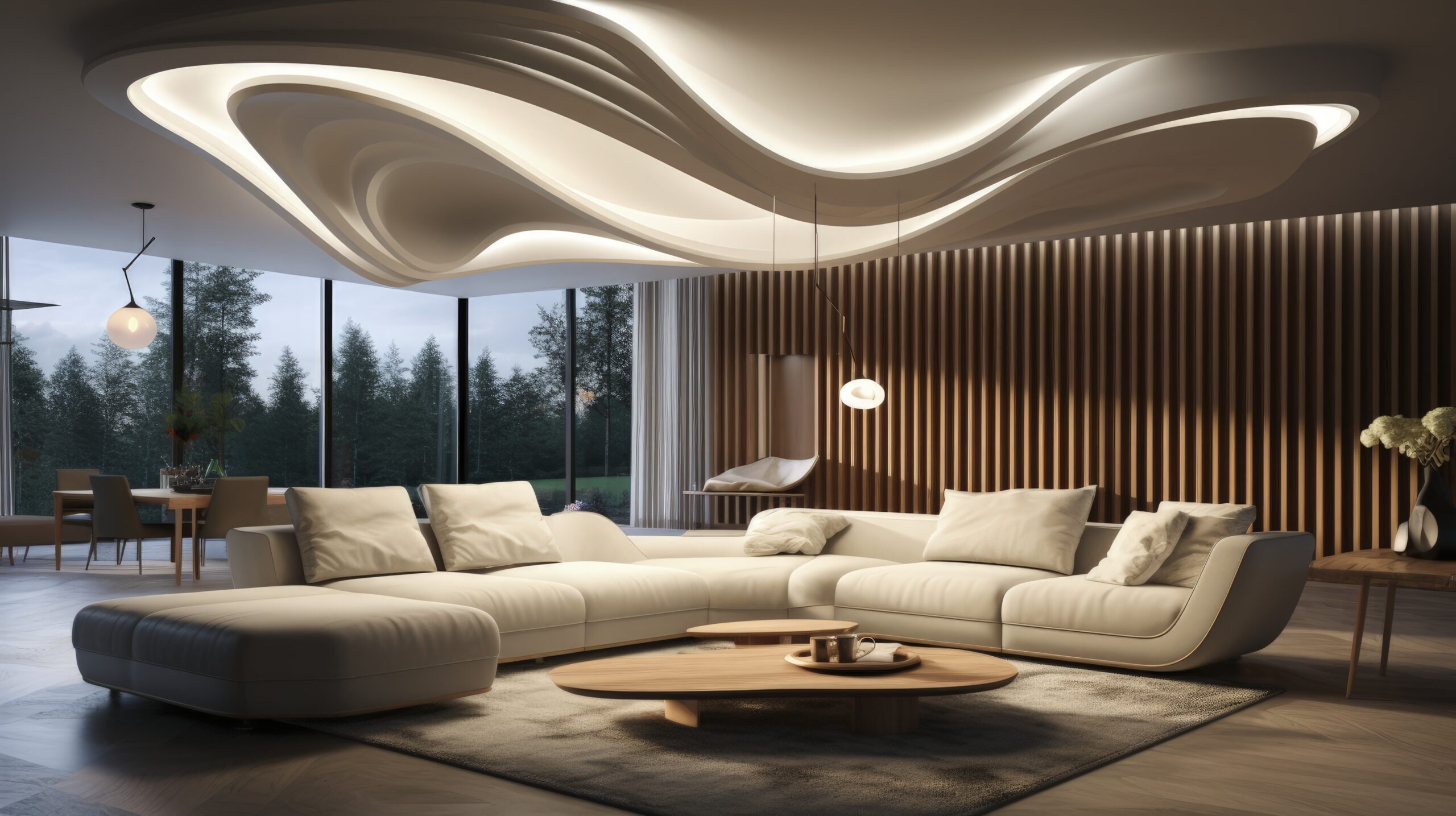In the world of décor, there are details that rarely steal attention, but change everything.
lighting isn’t just a switch we flip… it’s a language; its tone sets the mood, and its intensity whispers to the soul what we want to feel.
You might enter a room and feel an inexplicable warmth, or be automatically drawn to a certain corner, or find yourself more productive in one office than another. The secret? It’s not the furniture… it’s the light that touches it.
illumination isn’t neutral. It’s the most dramatic element in any space. It’s the hidden maestro behind harmony, tension, or tranquility.
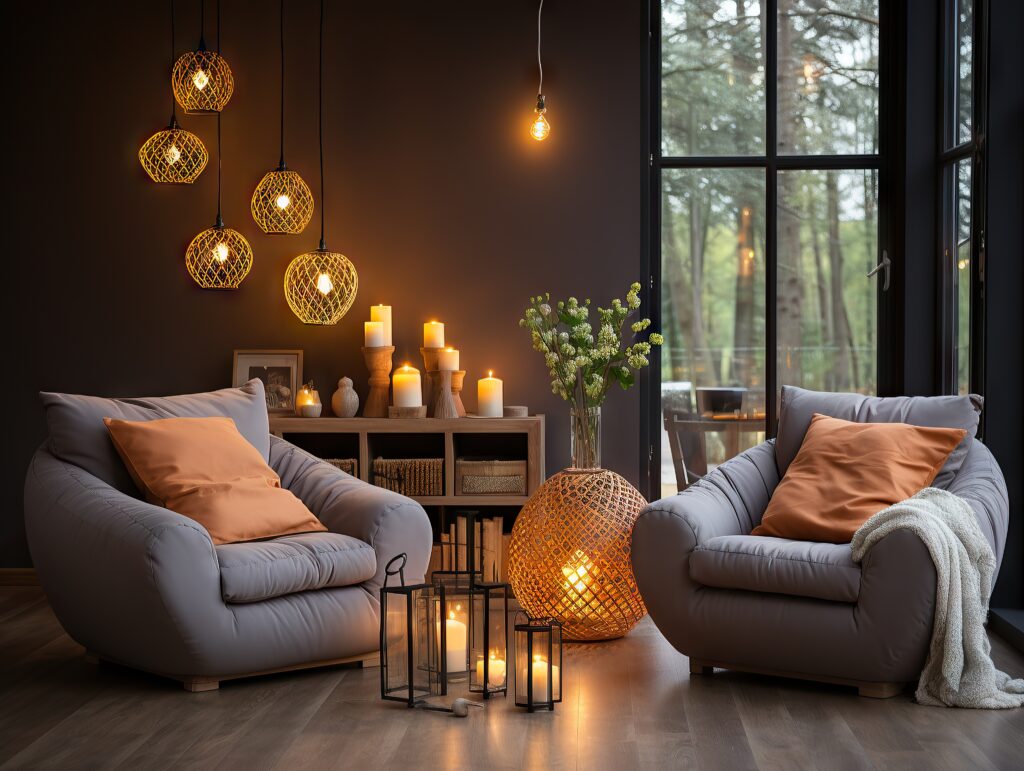
In a living room
It’s not just about the intensity of the light… but where do you direct the light? And for whom? And why?
You might fill the ceiling with thoughtful spotlights, or install a sculptural, contemporary chandelier that distributes light evenly throughout the space. This type of lighting—called ambient illumination— creates a sense of spaciousness and openness. It’s the foundation, like background music in a quiet movie… it surrounds you without stealing your attention.
But… the floor lamp next to the chair you sit in at the end of the day? That’s something else entirely.
That side light, falling at a perfect angle on your book or cup, doesn’t illuminate the room, it illuminates a moment. It creates intimacy, a small scene amidst a larger one… a warm moment, where you feel the light has chosen you over everything else in the space.
In the other corner, next to the guest sofa, you might place a ceramic or rattan table lamp to break the balance of light and create unexpected warmth. Here, you don’t “light” the room… you shape its features.
The beauty of living room illumination is that it’s built on layers. A general top layer, a middle layer of side lamps, and a final layer of hidden illumination—behind a curtain, on a shelf, or under a painting… This way, the room isn’t just a space, but a changing scenario, depending on the mood.
The ideal style for a living room?
Here, you have more flexibility. But the modern contemporary style or the elegant eclectic style are the most compatible. Modern offers a balance between visual purity and functionality, while eclectic allows you to play around with classic and contemporary lighting elements.
Materials used?
- Polished brass or matte black for wall and pendant lighting.
- Natural wood for floor lamp bases.
- Frosted or clear glass to soften the light.
- Thick fabrics in the “shed” to create visual warmth and reduce glare.
Supporting colors?
Amber, warm gray, shades of ivory white, and touches of olive or dark indigo… all colors that softly reflect light, giving the room a spacious yet intimate feel.
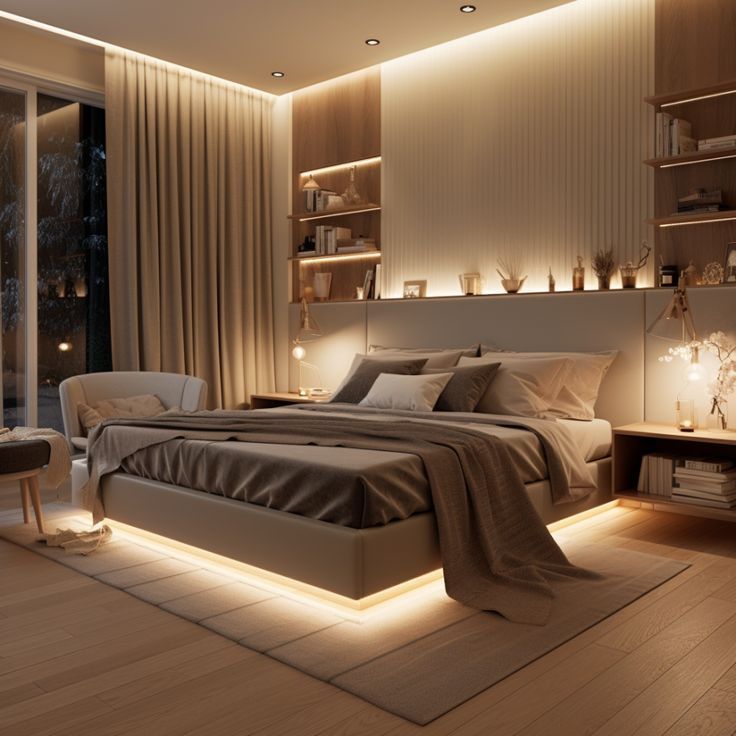
As for the Bedroom
It is a story of gradual tranquility…
A space that tolerates visual noise and does not welcome loud light. The light here doesn’t speak… it only whispers. It is a room where life enters without its hustle and bustle, but rather with tranquility at its fingertips. Start at the ceiling, where the chandelier is not the center of a show, but a poetic piece. A light chandelier, with a soft fabric design resembling linen or organza, scatters light like a caring mother’s sighs at night. No flicker, no harshness… just a light that gently filters through.
Then move to the sides, where each side lamp stands as a personal guardian of your comfort. Lamps with a base of natural wood or beige marble, and fabric shades in warm beige or pinkish gray. Their light doesn’t illuminate the room… it illuminates your moment.
As for the backlight at the headboard? It’s more like an unspoken secret. A discreet strip of light provides a warm backdrop for the bed, as if to say, “You are here… in the embrace of space.”
The ideal style for the bedroom?
Undoubtedly, the Japanese Zen or Japandi style, a blend of Scandinavian modernism and the depth of Japanese simplicity. A style that sanctifies “simplicity” and seeks tranquility through thoughtful space.
The ideal materials?
- Natural light wood: oak, beech.
- Fabric: linen, organic cotton, or light wool.
- Neutral colors: beige, pale gray, warm white, with olive or earthy tones.
- Frosted glass or handmade ceramics for lighting or accessories.
The key to the perfect bedroom?
Not feeling like you “see everything,” but rather that you live in every corner.
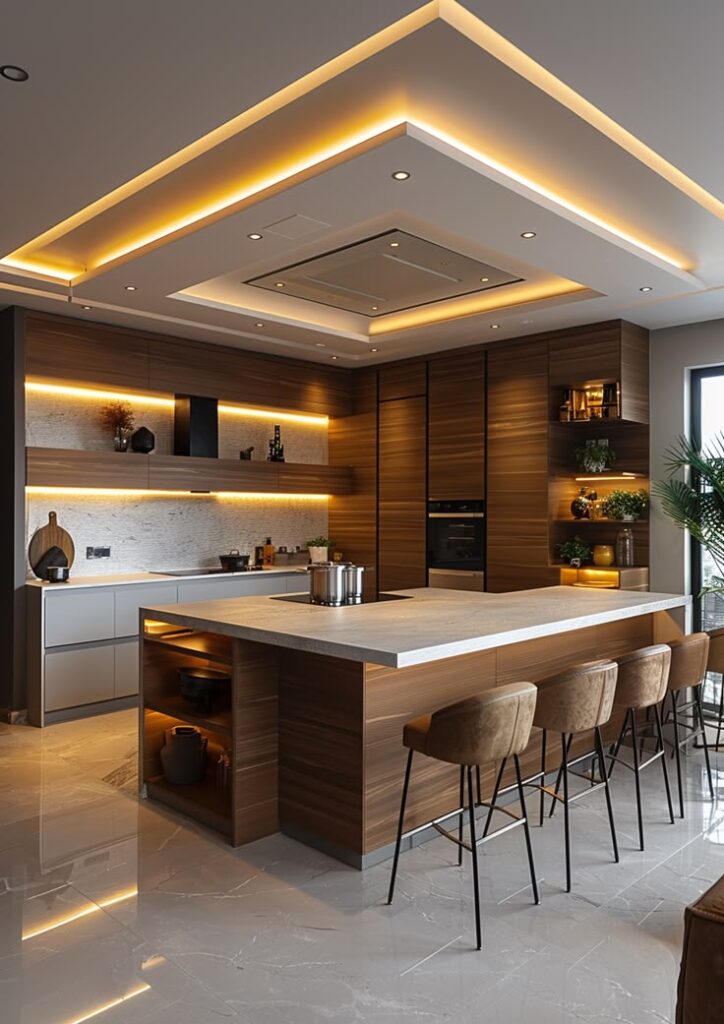
In the Kitchen…
There’s no room for coincidence.
Here, the story begins with a precise knife and meticulous detailing. Every millimeter of light must be accounted for, not only to create a beautiful atmosphere, but also to ensure that vegetables are cut straight across and that the shadow of a teaspoon doesn’t betray you.
Yes, in the kitchen, precision comes first.
Bright illumination from above—whether from LED ceiling lights or precise spotlights—is not just an option…it’s a necessity.
But…a well-lit kitchen doesn’t have to be intrusive. Even in the most functional spaces…beauty has the right to enter through the front door. Imagine a kitchen island, finished in a matte sand color or white marble with gold lines… Above it, three pendant lights in a metallic design — perhaps brass, matte black, or antique bronze.
These lights, despite their straightforward function, create an unforgettable visual rhythm, like musical pieces suspended from the ceiling, pulsing with taste.
Then we look beneath the cabinets…
There, hidden, dim light. A hidden strip of lighting, in a warm 3000K color, flows over the work surface…unobtrusive, yet knowing exactly what it should illuminate. On the surface, the cutting board and the spice bar…all come alive with this light, as if the kitchen is breathing quietly.
The ideal style?
- Industrial modern, where metal, wood, and sharp edges meet with surprising softness.
- Or minimalist Japandi, where every detail is thoughtful, and every light source serves a visual and psychological purpose.
The materials used?
- illumination: Matte metals like iron, brass, or black nickel.
- Surfaces: Marble or quartz in a neutral color that reflects light without glare.
- Cabinets: Natural wood or MDF with a matte finish, to create a balance between solid materials and light.
An important detail?
Even the illumination temperature makes all the difference:
Use 4000K illumination in prep areas for clear vision without being unsettlingly cold.
And 3000K illumination under cabinets or above the breakfast area for a warm feel.

Bathrooms…
those seemingly simple spaces, but in reality, they are the rooms most in need of deep visual understanding.
It’s where you start and end your day. It’s where you stand in front of the mirror, not just to adjust your hairstyle, but to face yourself—face to face with your features, under the light.
Yet, how many times have we made the illumination in the bathroom harsh, cold, and unsightly?
In the bathroom, a simple “light above the mirror” isn’t enough. The lamp casts its shadow on your face, creating circles where none existed… and amplifying fatigue rather than concealing it.
What the bathroom needs is a light that knows where it’s coming from.
Soft, side-lit lighting, positioned on either side of the mirror, resembles the light of dawn…
Not shocking, not dull, but soft, honest, and light on the skin.
This type of lighting reveals the facial details as they are—gently, realistically, and without artificiality.
It creates an ideal environment for personal care, morning meditation, or even for makeup applications that require precise color and shade selection.
Now let’s talk about the design of this lighting…
Side wall lamps with a simple design, perhaps with polished chrome or matte nickel bases, with frosted glass covers…
Or if you’re more of a luxury splurge, opt for matte gold or antique bronze bases, with touches of white marble or smooth porcelain.
For the ceiling, prefer soft, thoughtful illumination that doesn’t disturb or overwhelm.
You can choose small spotlights, but with warm white illumination no more than 3000K, to enhance the feeling of warmth and comfort.
The ideal style for bathrooms?
- Zin minimal, where simplicity meets nature, using beige and stone gray colors, with soft, muted lighting.
- Or the Modern spa, where the illumination is designed to lead you to relaxation, with mirrors in slim frames, and surfaces that are shiny but not glaring.
Materials used?
- White or beige marble for walls and countertops.
- Frosted glass for lamps.
- Touches of light or dark wood, depending on the style, add natural warmth.
A detail that can’t be ignored?
Use illumination built into the mirrors themselves, or behind them, to create a soft halo of light surrounding the face like moonlight—so-called backlit mirrors.
In bathroom corners, don’t forget the role of candles and hidden illumination, which transform at night into a ritual of calm and relaxation.
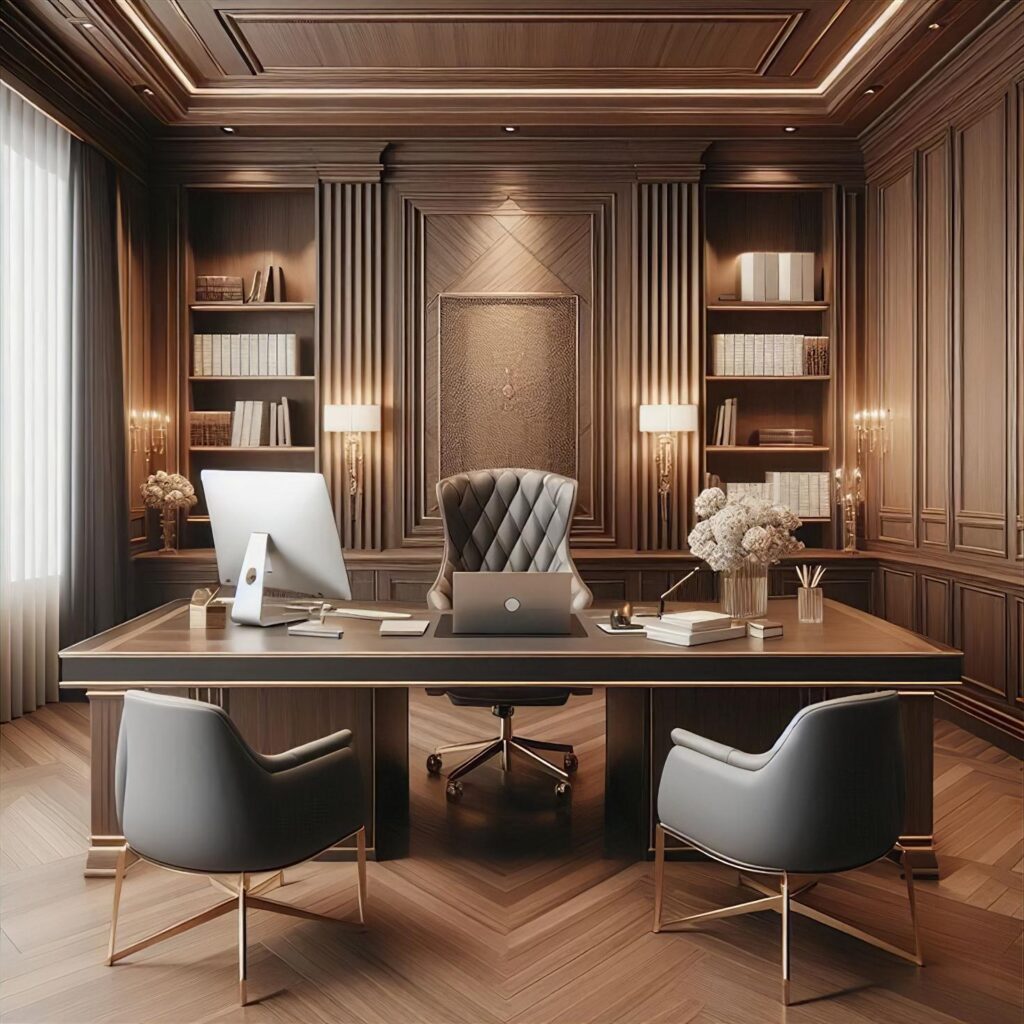
the Home offices…
A space that sometimes seems secondary, but is in fact the heart of creativity, productivity, and discipline within the home.
In this corner, there’s no room for coincidence…
Lighting here isn’t just aesthetics; it’s your primary ally in focusing and achieving.
Have you ever tried working under ill-considered light?
Dim light saps your energy, or too bright light strains your eyes?
You’ll immediately understand that lighting isn’t a detail…it’s a success or failure factor.
In the home office, we need illumination that resembles a calm leader:
Clear, strong, precise…but not shouty.
Lighting that guides your eyes to the page, the screen, or the idea—without disturbing your spirit.
Three materials are repeated in this space, like secret symbols of focus:
- Metal: Gives a sense of firmness and discipline. Metal desk lamps in silver or matte black add a professional touch.
- Matte black: The color of intelligent calm. It doesn’t distract, it doesn’t glare. The perfect backdrop for concentration.
- Clear glass: Because it doesn’t block light, it filters it. It adds lightness and elegance to the office without obstructing the view or the idea.
Imagine a desk lamp with an adjustable metal arm, with a soft industrial touch, that illuminates your keyboard or your notebook.
Or a pendant light with a slim black frame, suspended from the ceiling, spreading soft, diffused light across the entire office.
The perfect style for a home office?
- Contemporary industrial: Where metal and wood meet in a smart balance.
- Or minimalist modern, where calm spaces and clean lines clear the mind.
- A touch of Japandi style can be incorporated for those seeking a work environment that combines comfort and discipline.
Materials used?
- Dark-colored walnut or oak tabletops.
- Black or silver metal desk and chair frames.
- Lamps with clear glass or non-reflective finishes.
Daylight desk lighting around 4000K-5000K to balance mental energy.
And don’t forget the psychological element:
A nearby window allows natural light, or if there isn’t one, an additional dim light source in the corner of the room—perhaps a scented candle or hidden illumination behind bookshelves—helps transition between focused and meditative modes.
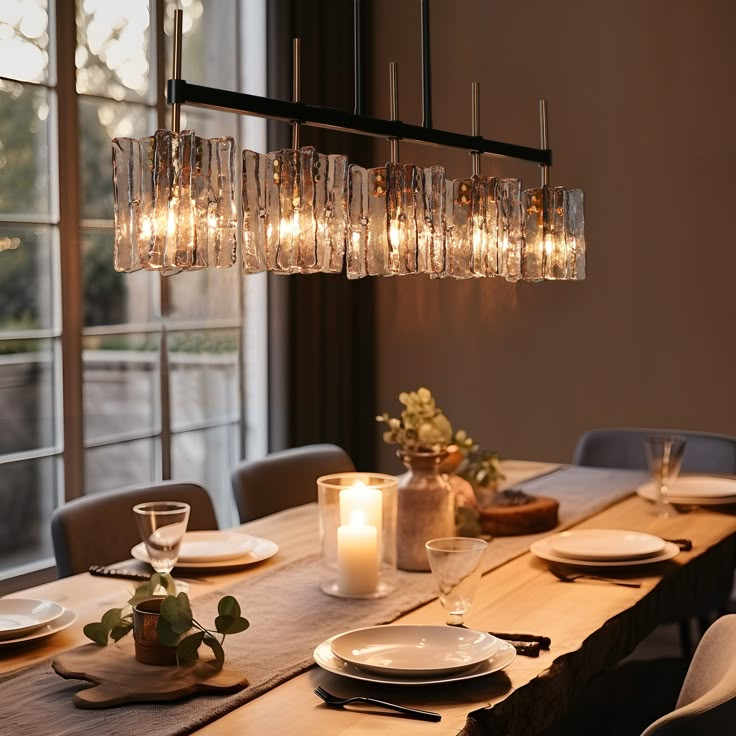
The Dining room…
where light doesn’t just illuminate the food, but also the stories.
In this particular space, lighting tells two stories at once: one about taste and the other about memories.
It’s the room that illuminates the faces of families, captures the smile of a guest, and warms the heart of a conversationalist between two bites. Here, we’re not looking for bright lighting like in the kitchen, nor dim illumination like in the bedroom… but rather lighting that combines inviting and distinctiveness.
Overhead lighting is king in the dining room,
but not just any light that looms above the table… Pendant chandeliers are the first choice, but on two conditions:
- Their height should match the ceiling height—usually 70 to 90 cm above the tabletop.
- Their size should match the width of the table—flooding it with soft light without stealing the attention.
Preferred materials?
- Smoked or clear glass for soft, non-harsh lighting.
- Matt metal—black, gold, or bronze—for a touch of luxury.
- Or even natural wood for those who prefer a warm, rustic feel.
The ideal style?
- New classic: For lovers of warmth and elegance: a light golden chandelier with LED candles on the table.
- Modern minimalism: Pendant illumination with a simple geometric line and a solid color.
- Or even eclectic for those who love boldness: a chandelier with unexpected colorful touches that break the mold and spark conversation.
And don’t forget about side lighting, such as lampshades or sconces on nearby walls—these elements create layers of light, making the room feel deeper and warmer.
A hidden tip: Choose illumination with a warm temperature (2700K–3000K), which is best for eating and talking.
Because we don’t just eat with a spoon, but also with the comfort our bodies feel under the light.
But the beauty of light doesn’t stop with the type of room…it extends to the style itself.
In classic designs, crystal and bronze shine, while in industrial designs, lighting appears bold, with exposed strings and large bulbs that highlight the rawness.
In Scandinavian or Japanese styles, the light is soft, flowing like water, coming from paper or wooden lamps that don’t attract attention but rather create a soothing atmosphere.
Have you ever wondered: How can I know which type of lighting is right for my space? This is where artificial intelligence comes in, and this is where Zory’s AI journey begins.
At Zory, we no longer just offer ideas… we read your taste and suggest what suits you.
With a huge library of designs, powered by intelligent recommendations, we help you choose the illumination (and furniture) that suits your room, your style, and even your mood.Because illumination isn’t just what you see… it’s what you feel without even realizing it.
